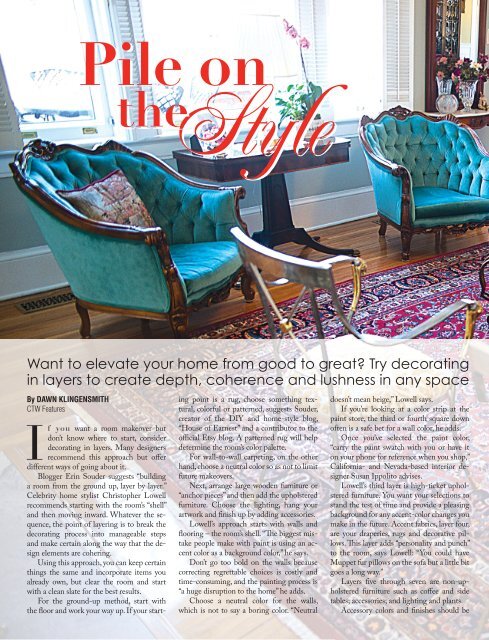o_19he0575hpoc1ij71qst10om6tsa.pdf
You also want an ePaper? Increase the reach of your titles
YUMPU automatically turns print PDFs into web optimized ePapers that Google loves.
Want to elevate your home from good to great? Try decorating<br />
in layers to create depth, coherence and lushness in any space<br />
By DAWN KLINGENSMITH<br />
CTW Features<br />
If you want a room makeover but<br />
don’t know where to start, consider<br />
decorating in layers. Many designers<br />
recommend this approach but offer<br />
different ways of going about it.<br />
Blogger Erin Souder suggests “building<br />
a room from the ground up, layer by layer.”<br />
Celebrity home stylist Christopher Lowell<br />
recommends starting with the room’s “shell”<br />
and then moving inward. Whatever the sequence,<br />
the point of layering is to break the<br />
decorating process into manageable steps<br />
and make certain along the way that the design<br />
elements are cohering.<br />
Using this approach, you can keep certain<br />
things the same and incorporate items you<br />
already own, but clear the room and start<br />
with a clean slate for the best results.<br />
For the ground-up method, start with<br />
the floor and work your way up. If your start-<br />
16<br />
ing point is a rug, choose something textural,<br />
colorful or patterned, suggests Souder,<br />
creator of the DIY and home-style blog,<br />
“House of Earnest” and a contributor to the<br />
official Etsy blog. A patterned rug will help<br />
determine the room’s color palette.<br />
For wall-to-wall carpeting, on the other<br />
hand, choose a neutral color so as not to limit<br />
future makeovers.<br />
Next, arrange large wooden furniture or<br />
“anchor pieces” and then add the upholstered<br />
furniture. Choose the lighting, hang your<br />
artwork and finish up by adding accessories.<br />
Lowell’s approach starts with walls and<br />
flooring – the room’s shell. “The biggest mistake<br />
people make with paint is using an accent<br />
color as a background color,” he says.<br />
Don’t go too bold on the walls because<br />
correcting regrettable choices is costly and<br />
time-consuming, and the painting process is<br />
“a huge disruption to the home” he adds.<br />
Choose a neutral color for the walls,<br />
which is not to say a boring color. “Neutral<br />
doesn’t mean beige,” Lowell says.<br />
If you’re looking at a color strip at the<br />
paint store, the third or fourth square down<br />
often is a safe bet for a wall color, he adds.<br />
Once you’ve selected the paint color,<br />
“carry the paint swatch with you or have it<br />
on your phone for reference when you shop,”<br />
California- and Nevada-based interior designer<br />
Susan Ippolito advises.<br />
Lowell’s third layer is high-ticket upholstered<br />
furniture. You want your selections to<br />
stand the test of time and provide a pleasing<br />
background for any accent-color changes you<br />
make in the future. Accent fabrics, layer four,<br />
are your draperies, rugs and decorative pillows.<br />
This layer adds “personality and punch”<br />
to the room, says Lowell: “You could have<br />
Muppet fur pillows on the sofa but a little bit<br />
goes a long way.”<br />
Layers five through seven are non-upholstered<br />
furniture such as coffee and side<br />
tables; accessories; and lighting and plants.<br />
Accessory colors and finishes should be



